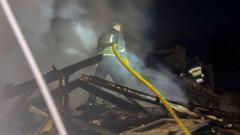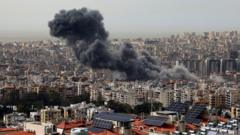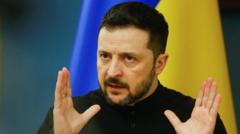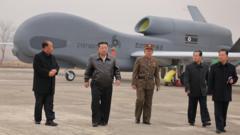As Ukraine continues to innovate in drone technology, particularly with the long-range Raybird, uncertainty looms over the effectiveness of the recent energy ceasefire with Russia. Engineers express skepticism about Russia's compliance with the agreement, fearing renewed conflict could emerge.
Ukraine's Drone Developers Prepare for Uncertain Future Amidst Ceasefire Doubts
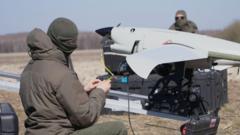
Ukraine's Drone Developers Prepare for Uncertain Future Amidst Ceasefire Doubts
Concerns linger among Ukrainian engineers about the sustainability of a new ceasefire agreement with Russia while advancing drone technology promises deep strikes into enemy territory.
At a clandestine testing facility in Ukraine, engineers are hard at work on their latest drone innovation, the Raybird, designed to extend military reach deep into Russian territory. This advanced drone, resembling a sleek miniature aircraft, boasts an impressive range of over 1,000 km (620 miles) and the ability to conduct missions for up to 20 hours. Among its intended targets are essential energy infrastructure sites within Russia, including oil refineries and fuel depots.
However, this cutting-edge technology's future operations may be jeopardized by a partial ceasefire agreement recently brokered with the US, where both Ukraine and Russia agreed to halt attacks on each other's energy resources. These negotiations took place amid a maritime ceasefire discussion in Saudi Arabia, with Ukrainian President Volodymyr Zelensky vowing immediate compliance with the terms set forth.
Yet, skepticism remains in the ranks of Ukraine's defense engineers, particularly Oleksiy from Skyeton, the firm responsible for the Raybird's development. He voiced doubt over Russia's sincerity, describing a pattern of aggression followed by verbal agreements that do little to ensure peace, stating, "The possibility that they will continue fighting remains."
This ceasefire is crucial for Russia as well, given Ukraine's relentless drone assaults which have reportedly led to a significant 10% reduction in Russia's oil refining capacity. As a result of these attacks, Russian authorities have extended a ban on petroleum exports, indicating the country's economic vulnerability.
On the other hand, Ukraine's capability for long-range strikes is surging, with recent announcements from President Zelensky about an advanced drone that could reach targets as far as Siberia. Additionally, there are reports of newly designed turbojet-powered missile-drones and upgraded cruise missiles, including successful tests of a domestically produced ballistic weapon.
While the ceasefire offers some reprieve for Ukraine, it remains a harsh reality that Russia has frequently targeted Ukrainian energy infrastructure. Last year, Ukrainian energy generation plummeted to a third of its pre-war levels, and recent assaults on gas storage facilities depict ongoing challenges for Ukraine's energy security.
As tests conclude for the Raybird, and the drone lands safely at the testing facility, Oleksiy reflects on the volatile situation. "Although it's good to have a ceasefire, we still cannot afford to pause our work," he insists. The realities of potential future conflict fuel their innovation, as they prepare for whatever may unfold next in the ongoing war.


